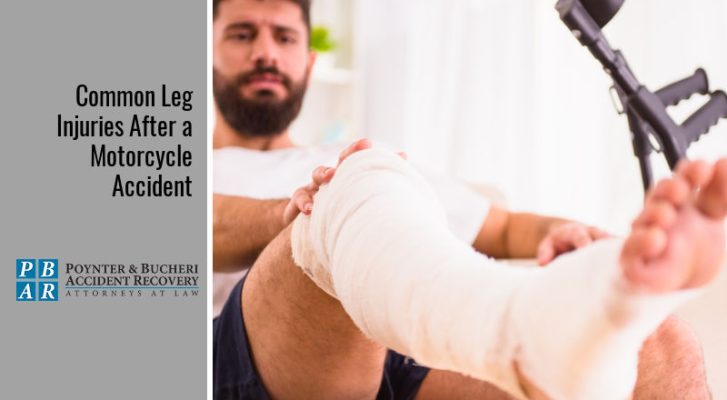
Common Leg Injuries After a Motorcycle Accident

Motorcyclists don’t have the benefit of being surrounded by steel, rubber, plastic, and aluminum like car drivers and passengers. Instead, they balance on vehicles that weigh an average of 300-500 pounds and share the road with cars that weigh an average of 4,094 pounds, not to mention SUVs and trucks that can weigh up to 6,000 pounds. Oh yes, don’t forget the semi-trucks that can tip the scales at 10,000 – 80,000 pounds fully loaded. The point is, experiencing the joy, freedom, and adrenaline rush of driving a two-wheeled vehicle down the open road comes at considerable risk.
In Indiana, there were 2,943 motorcycle accidents in 2020, an increase of 9% from 2019. Tragically, these accidents caused 138 fatalities. They also resulted in 1,969 nonfatal injuries.
Motorcyclists can sustain head injuries, arm injuries, and internal injuries, but the most common injuries by far (47%) occur to the lower extremities, such as the foot, ankle, leg, knee, thigh, hip, and pelvis.
Why Are Motorcycle Leg Injuries So Prevalent?
- In motorcycle crashes, drivers or riders can be crushed by the bike falling on them.
- Motorcyclists are often thrown from their vehicles during accidents.
- In many cases, people can be dragged along the ground during a crash.
- Not only can this result in crushed or broken limbs, but also road rash.
- Road rash is far more serious than its name would suggest; in especially egregious cases, skin and muscle can be peeled back to the bone.
- Some motorcyclists don’t wear adequate protective clothing. People seem to have gotten the message about how important helmets are, but they often neglect to wear boots that protect their ankles or safe riding pants that protect their legs. Regular denim jeans have an abrasion resistance level of .5 seconds. In other words, they will break and expose the skin in half a second. This is clearly insufficient since it is likely that a rider will slide for several seconds in an accident.
- On busy or congested roadways, motorcyclists can be clipped by passing vehicles.
- Car drivers or passengers frequently exit their parked vehicles without looking behind them; this can cause a car door to hit an oncoming motorcyclist.
What Are the Most Common Leg Injuries After a Motorcycle Accident?
- Foot injuries: According to an NHTSA (National Highway Traffic Safety Administration) study, foot injuries accounted for 10% of lower extremity injuries after motorcycle accidents. Foot injuries include:
- Metatarsal or tarsal fractures
- Calcaneus fractures
- Talus fractures
- Foot fractures
- Toe injuries include amputation, crushing, or “degloving.” (Degloving is also called avulsion and is when the top layer of skin and tissues are ripped from the underlying “muscle, connective tissue, or bone.”)
- Ankle injuries:
- Fibula fracture
- Tibia fracture
- Ankle dislocation
- Leg injuries:
- Tibia fracture
- Fibula fracture
- Leg amputation
- Achilles tendon laceration
- Knee injuries:
- Tibia fracture
- Patella fracture
- Collateral or cruciate ligament laceration
- Dislocated, sprained, or lacerated knees
- Thigh injuries:
- Various types of femur fractures
- Femoral Artery/Vein-Sciatic nerve injuries
- Partial or complete above-the-knee amputations
Motorcycle Leg Injuries – Treatment & Recovery
Leg injuries vary from case to case. You may not know how to tell if a bone is fractured or bruised at first glance. This is why it is so important to seek medical attention immediately after a motorcycle accident if you think you have suffered any type of injury.
Even so-called “simple” lacerations and bruises can take time to heal. And when it comes to the most common leg injuries after motorcycle accidents – fractures – the recovery time can be long and arduous. For example, broken legs can take 4-6 months to heal. During this time, you will most likely be unable to work. You will be dealing with medical expenses that may include ambulance costs, hospitalization, surgery, medication, and rehabilitation. You will also likely deal with lost wages. If another driver’s negligence caused your accident, you deserve compensation. However, in the midst of dealing with a possibly debilitating injury with long-term consequences, you will be unlikely to want to deal with the emotional strain of insurance company negotiations. This is why it is important to work with an experienced and competent Indianapolis motorcycle accident lawyer.
Poynter & Bucheri – Indianapolis Motorcycle Accident Lawyers
Our motorcycle injury lawyers are experienced with cases like yours and can evaluate what your case may be worth. Plus, we charge no attorney fees, unless you win. Call today for a free case review at 1-800-265-9881, or contact us online.
